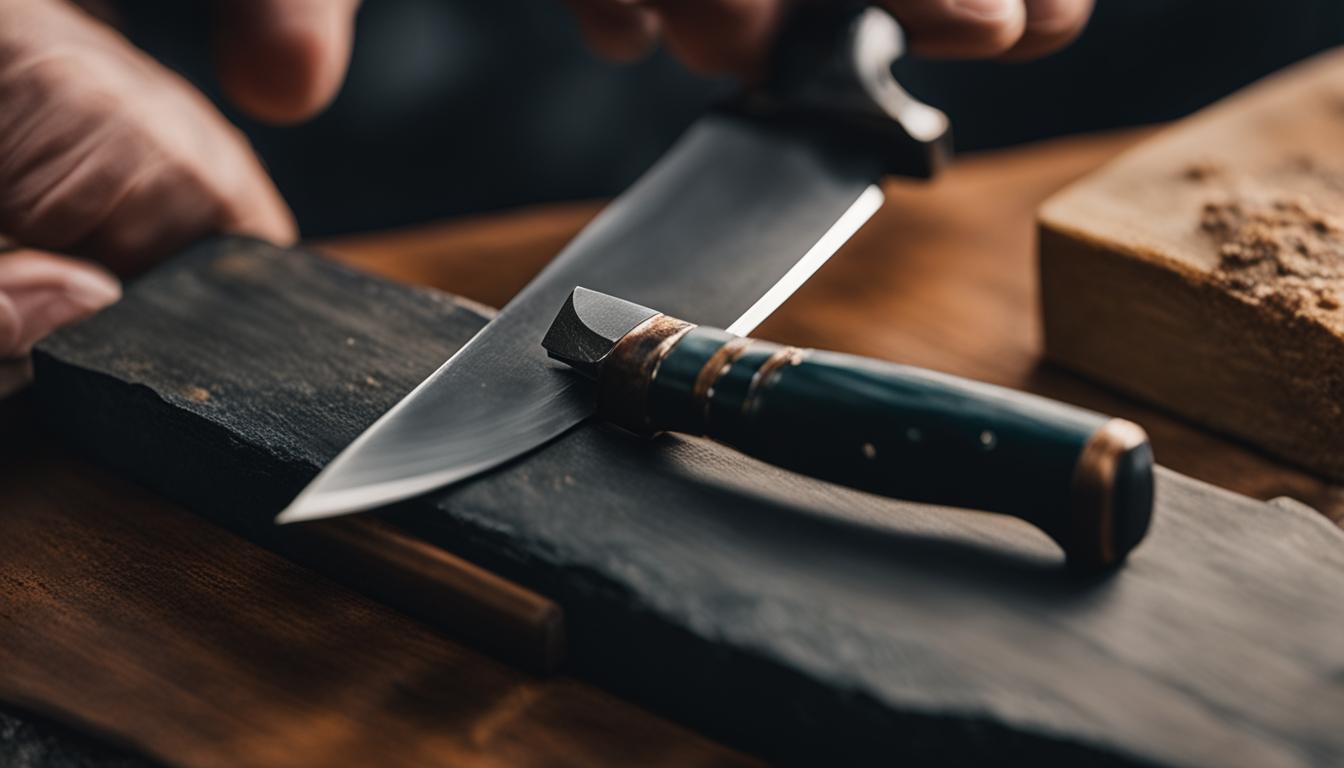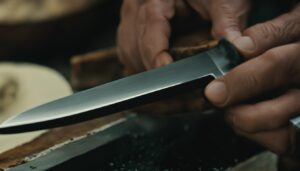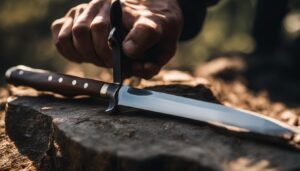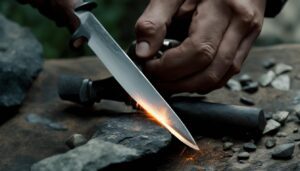Proper knife maintenance is crucial for preserving the longevity of your hunting knife. By following these essential tips, you can ensure that your knife stays sharp and reliable, lasting you for many years of outdoor adventures.
Taking care of your knife includes cleaning it regularly, lubricating the blade, and storing it properly. Additionally, using your knife for its intended purpose and choosing the right type of steel for the blade are important factors to consider.
Key Takeaways:
- Regularly clean your hunting knife to remove dirt, preventing rust or corrosion.
- Lubricate the blade with an appropriate oil to reduce friction and prevent corrosion.
- Store your knife in a cool, dry place and use a sheath or acid-free paper for protection.
- Use your knife for its intended purpose to avoid damage and ensure longevity.
- Choose the right type of steel for your hunting knife’s blade for optimal performance.
Importance of Proper Knife Use and Care
Proper knife use and care are essential for maintaining the longevity and performance of your hunting knife. Understanding the purpose of your knife is the first step in ensuring its effectiveness and durability. A hunting knife is specifically designed for tasks such as skinning, field dressing, and preparing game. It is important to use the knife for its intended purpose and avoid activities that can damage the blade, such as using it to cut wood or branches.
In addition to using the knife correctly, regular cleaning and maintenance are crucial. After each use, it is recommended to clean the knife thoroughly with soap and warm water to remove dirt and debris. This not only keeps the knife hygienic but also prevents the chance of rust or corrosion. Proper lubrication of the blade is also important to maintain its performance. Applying a small amount of oil suitable for the knife’s material can reduce friction, improve cutting ability, and protect against corrosion.
While basic cleaning and lubrication can be done at home, there are situations where professional services from a bladesmith may be required. A bladesmith specializes in the craft of creating, repairing, and maintaining knives. If your knife requires significant restoration, sharpening, or any other intricate work, it is advisable to consult a professional bladesmith for expert care. They have the knowledge, skills, and specialized equipment to handle complex knife maintenance tasks.
Proper storage of your hunting knife is also crucial for preventing damage and ensuring its longevity. Storing the knife in a cool, dry place is ideal to prevent humidity and moisture-related issues. Additionally, using a sheath or wrapping the knife in acid-free paper can provide an extra layer of protection against scratches and corrosion. By following these tips and best practices, you can ensure that your hunting knife remains in optimal condition for years to come.
| Proper Knife Use and Care | Importance |
|---|---|
| Use the knife for its intended purpose | Ensures effectiveness and durability |
| Clean the knife after each use | Prevents rust and corrosion |
| Lubricate the blade regularly | Reduces friction and improves performance |
| Consult a bladesmith for professional maintenance | Ensures expert care for complex tasks |
| Store the knife in a cool, dry place | Prevents humidity and moisture-related issues |
Choosing the Right Knife for Survival Situations
When it comes to survival situations, having the right knife can make all the difference. There are a variety of knife types to consider, each with its own advantages and limitations. Understanding the differences between fixed-blade knives and folding knives is crucial in selecting the right tool for your needs.
Fixed-Blade Knives
Fixed-blade knives are known for their durability and strength. They are designed to handle heavy-duty tasks and are ideal for chopping wood, hunting, and other demanding activities. These knives have a solid construction, with the blade being a single piece of steel that extends into the handle. This design provides stability and allows for greater force to be exerted without the risk of the blade folding or breaking.
Folding Knives
Folding knives, on the other hand, offer greater portability and versatility. They consist of a blade that can be folded into the handle, making them compact and easy to carry. Folding knives are suitable for situations where portability is a concern, as they can fit into pockets or be attached to a belt. While they may not be as robust as fixed-blade knives, folding knives are still capable of handling various tasks and can be used for survival situations that don’t require heavy-duty cutting or chopping.
Choosing the Right Skinning Knife
When it comes to skinning game, having the right knife is essential for efficiency and precision. Skinning knives come in various shapes and sizes, each designed to perform specific tasks. Consider the following features when selecting a skinning knife:
- Blade shape: A curved blade is ideal for precise skinning, while a drop-point blade offers versatility for both skinning and general use.
- Blade length: Choose a blade length that matches the size of the game you’ll be skinning.
- Handle material: Look for a handle material that provides a secure grip, even when wet or slippery.
- Blade steel: Different types of steel offer varying degrees of hardness, corrosion resistance, and ease of sharpening. Consider your priorities in these areas when selecting a skinning knife.
Summary
When it comes to survival situations, choosing the right knife is essential for your safety and success. Fixed-blade knives are durable and reliable, making them ideal for heavy-duty tasks. Folding knives offer portability and versatility, making them suitable for a wide range of survival situations. When selecting a skinning knife, consider factors such as blade shape, length, handle material, and blade steel to ensure optimal performance. By choosing the right knife for your needs, you can be better prepared for any survival scenario.
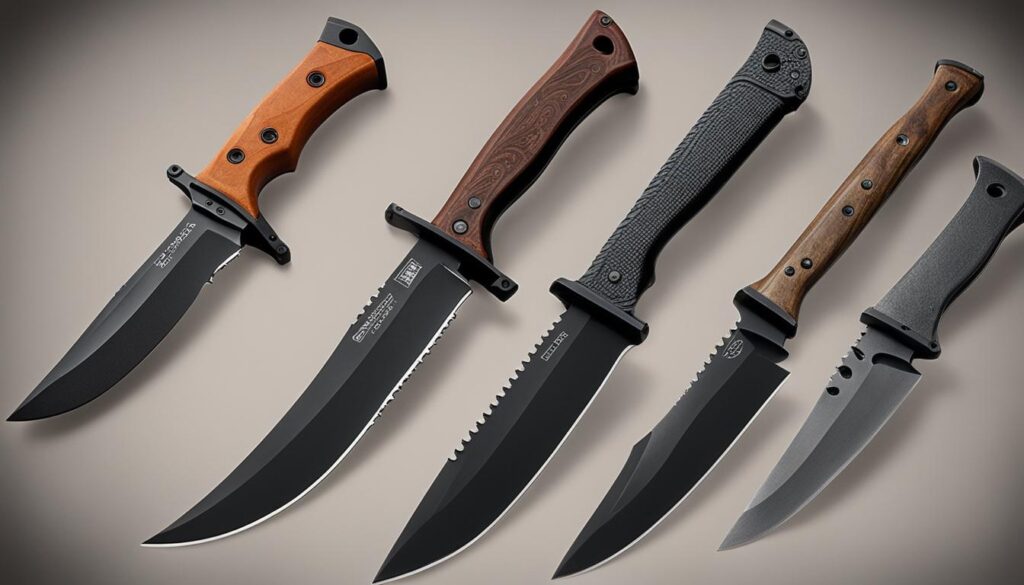
Maintaining Your Skinning Knife for Long-Term Performance
Proper maintenance is crucial for ensuring the long-term performance of your skinning knife. By following these essential tips, you can keep your knife in optimal condition for efficient skinning and durability.
Sharpening Techniques
Regular sharpening is key to maintaining a sharp blade on your skinning knife. Using a sharpening stone or rod, carefully sharpen the blade at a consistent angle to ensure an even edge. Take care not to over-sharpen, as this can reduce the life of the blade. Remember to sharpen both sides of the blade to maintain symmetry and cutting performance.
Cleaning and Drying
Properly cleaning your skinning knife after each use is essential for preventing rust and corrosion. Use warm soapy water and a soft cloth or brush to remove any dirt, blood, or debris from the blade. Pay special attention to the handle and pivot areas, ensuring all residue is thoroughly cleaned. After cleaning, make sure to dry the knife completely to prevent moisture from causing damage.
Lubrication
Applying lubrication to your skinning knife is important for keeping it operating smoothly and protecting it from moisture. Use a high-quality knife oil or lubricant and apply a small drop to the pivot areas to maintain smooth movement. Avoid using excessive amounts of oil, as this can attract dirt and debris. Regular lubrication will help prevent rust and ensure your knife continues to perform optimally.
Common Maintenance Mistakes
When maintaining your skinning knife, it’s important to avoid common mistakes that could compromise its performance. Over-sharpening can lead to excessive wear on the blade and reduce its lifespan. Neglecting to address rust or corrosion in a timely manner can cause irreversible damage. Additionally, using the wrong lubricant or applying too much can attract debris and affect the knife’s operation. By being mindful of these mistakes, you can ensure the longevity and performance of your skinning knife.
Knife Safety Considerations
When using a skinning knife, it’s crucial to prioritize safety. Always keep your knife sharp, as a dull blade can slip and cause accidents. Maintain a proper grip and posture when handling the knife, ensuring full control and minimizing the risk of injury. Avoid using the knife for tasks it is not designed for, as this can lead to blade damage or accidents. By following these safety considerations, you can enjoy using your skinning knife with confidence.
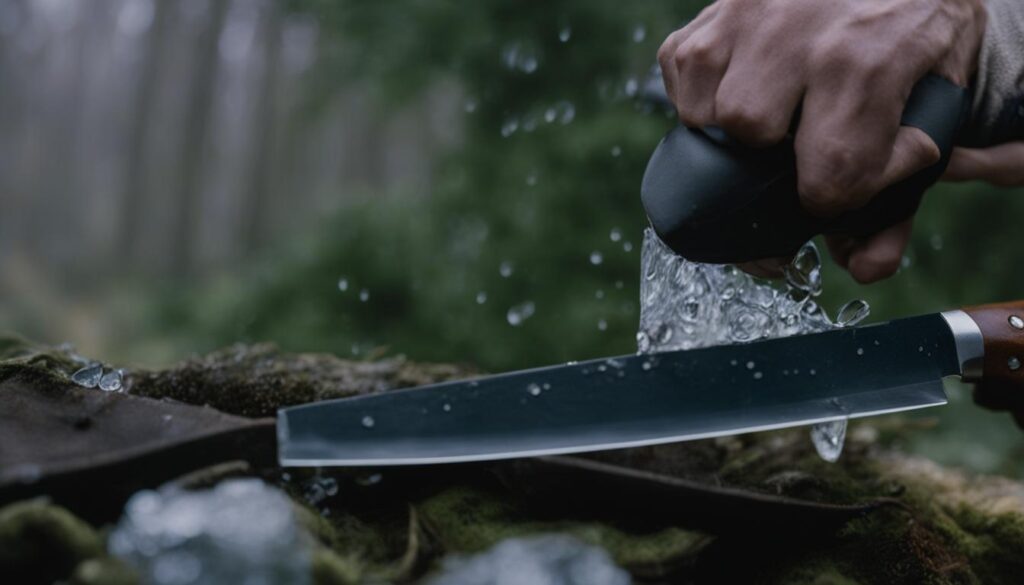

| Common Maintenance Mistakes | Effect on Knife Performance |
|---|---|
| Over-sharpening | Reduces blade lifespan |
| Neglecting rust or corrosion | Causes irreversible damage |
| Using wrong lubricant | Affects knife operation |
Conclusion
In conclusion, proper care and maintenance are essential for ensuring the longevity and performance of your hunting and skinning knives. By following the tips provided in this article, you can keep your knives in optimal condition, ready for any adventure or survival situation.
Remember to always use your knife for its intended purpose, as using it for tasks it is not designed for can result in damage to the blade. Regular cleaning with warm soapy water and thorough drying will prevent rust and corrosion, while lubrication of the blade and folding mechanism (if applicable) will ensure smooth operation and protect against wear.
Lastly, proper storage is crucial in preserving the quality of your knives. Keep them in a cool, dry place, and consider using a sheath or acid-free paper to protect them from humidity and prevent mold.
By implementing these maintenance practices and taking care of your knives, you can enjoy the long-lasting durability, reliability, and performance that they offer in various survival situations.
FAQ
Why is proper knife maintenance important?
Proper knife maintenance is important for preserving the longevity of your hunting knife and ensuring its performance in outdoor adventures.
How often should I clean my knife?
It is recommended to clean your knife after each use to remove dirt and prevent rust or corrosion.
What type of oil should I use to lubricate the blade?
It is important to use an appropriate oil to lubricate the blade, such as a lubricating oil specifically formulated for knives.
When should I contact a bladesmith for professional care or restoration?
If your knife requires professional attention, such as blade repair or restoration, it is recommended to contact a skilled bladesmith.
How should I store my knife to protect it from humidity?
It is best to store your knife in a cool, dry place and use a sheath or wrap it in acid-free paper to protect it from humidity and prevent mold.
What are the main types of knives to consider for survival situations?
The main types of knives to consider are fixed-blade knives and folding knives, each with their own advantages for different tasks and portability needs.
How should I maintain my skinning knife for long-term performance?
Regular sharpening using a sharpening stone or rod, cleaning with warm soapy water, and proper lubrication are essential for maintaining the performance of your skinning knife.
What are some common maintenance mistakes to avoid?
Some common maintenance mistakes to avoid include over-sharpening the blade, neglecting rust or corrosion, and using the wrong type of lubricant.
What safety considerations should I keep in mind when using a skinning knife?
Safety considerations when using a skinning knife include keeping the blade sharp, using a proper grip and posture, and avoiding tasks that the knife is not designed for.
